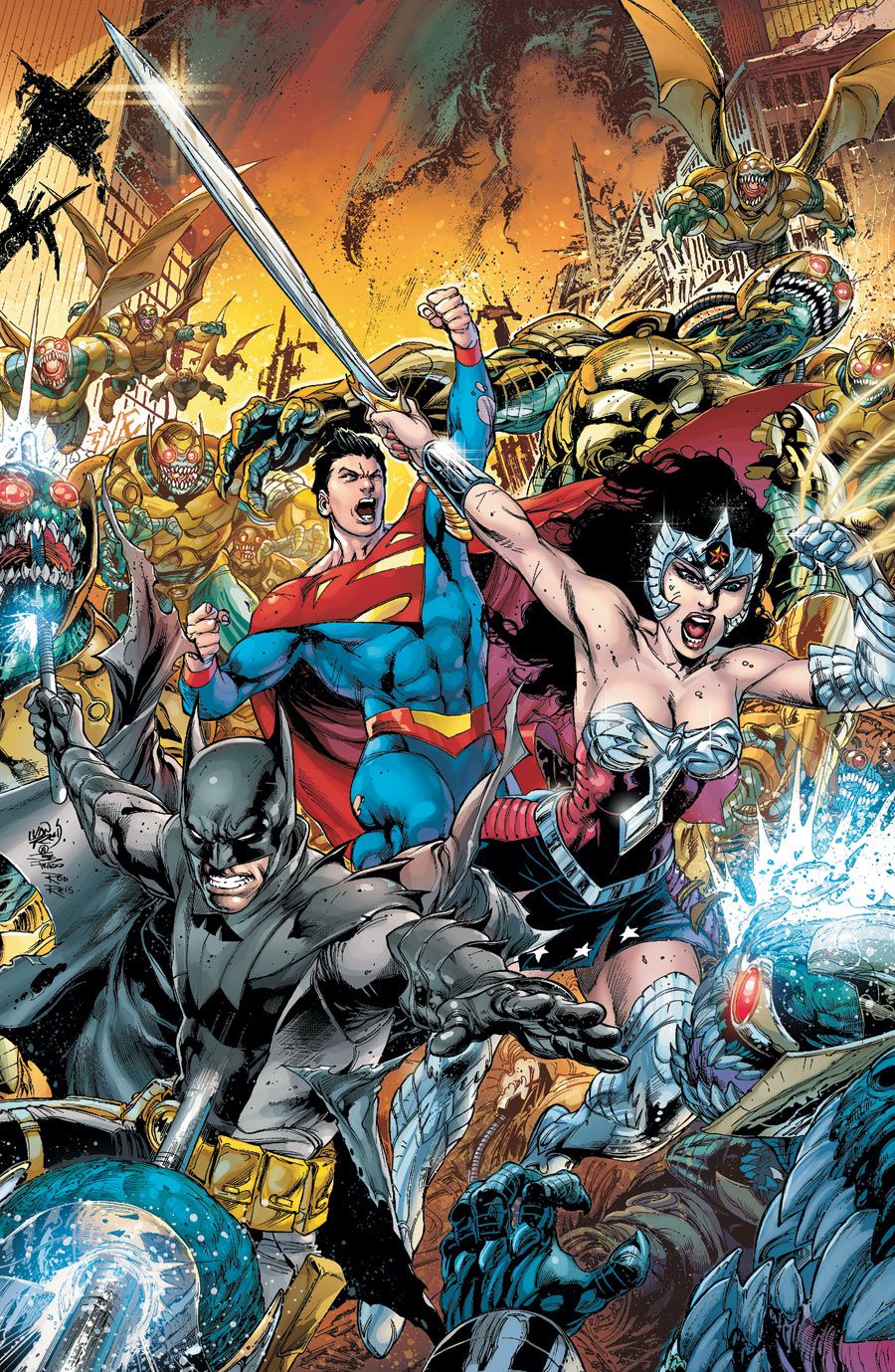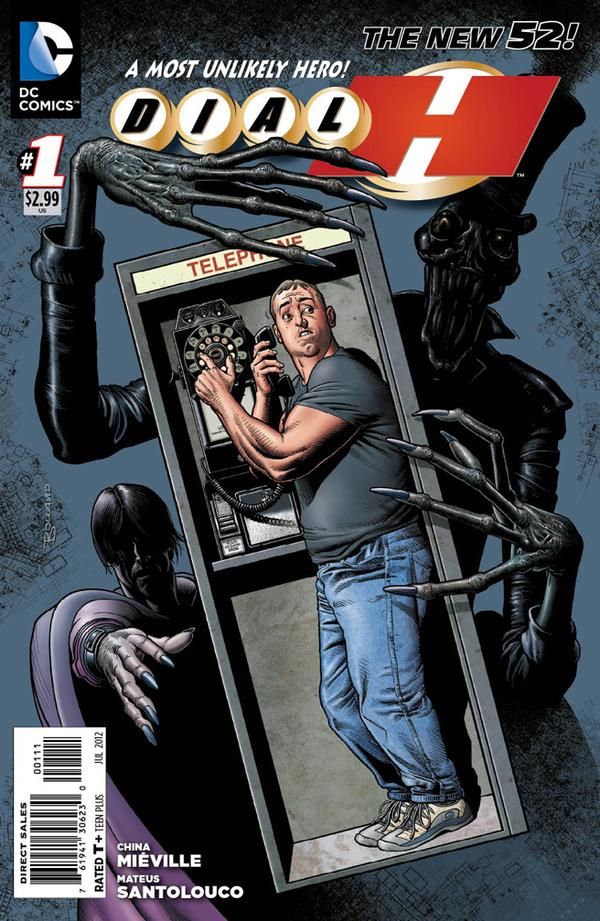DC Comics released four of the six "New 52 Second Wave" titles this past week, making it hard to choose what to focus on this week ... so I figured I wouldn't. Instead, here are round-ups of reviews for all four titles: Earth 2 #1 by James Robinson, Nicola Scott, Trevor Scott and Alex Sinclair; Dial H #1 by China Miéville, Mateus Santolouco, Tany Horie and Richard Horie; World's Finest #1 by Paul Levitz, George Pérez, Scott Koblish, Kevin Maguire, Hi-Fi and Rosemary Cheetham; and G.I. Combat #1 by J.T. Krul, Justin Gray, Jimmy Palmiotti, Ariel Olivetti and Dan Panosian.
Earth 2
Keith Callbeck, Comicosity: "The multiverse returns! To fanfare or dread, depending on how you feel about pre-Crisis DC. But this is not your parents’ Earth 2. Completely reimagined by James Robinson, the creator most responsible for bringing the JSA back to the DCU with his series Golden Age, this Earth 2 is a world recovering from war. The story feels like a really good Elseworlds book (which Golden Age was as well) and not a What If…? type tale, though that element exists.The heroes of Earth 2 have existed for much longer than the five years of Earth Prime. When the parademons attack, paralleling the first arc of Johns’ Justice League, it is a much more mature Superman, Wonder Woman and Batman there to battle them."
Kevin Finnigan, Comic Book Therapy: "Earth 2 #1 is really one big fight. It might not focus much on the heroes of this book, but it does lay the groundwork for the rest of the series. James Robinson gives the big fight an epic feel, which makes the rest of the issue hit that much harder. But where most of these characters (spoilers) don’t survive the issue, most of the issue seems like a moot point. The fight would have worked better if it didn’t take up two-thirds of the issue. Another idea would have been to keep the fact that these characters were going to die. Robinson does a good job of making these characters similar to their Earth 1 counterparts, but differentiates them enough to warrant this book. The few small changes add up to make the reader want to read more of these characters. Another bad decision was having two of the most interesting characters fly off to another book. It’s never good to say 'See their adventure in (insert title)!' It really puts the reader off and seems like a cheap way to gain more money."
Minhquan Nguyen, Weekly Comic Book Review: "Yet even the ancient tales of Ragnarok foretold that a new world would come of it, so consider the fall of the old heroes, old as they are, as a necessary step for the new to rise. Robinson uses the opportunity of DC’s relaunch to look at Alan Scott, Jay Garrick, and Al Pratt anew. While they’ve lost their elder statesmen status, and the respect and wisdom that came with it, their youth and Robinson’s smart character work makes them, if anything, more accessible than ever. You get a great sense of Alan’s centeredness, Jay as a man of the people (even at age 21), and Al’s outstanding courage before they put on any kind of costume, reminding you that the Society’s appeals comes from their innate heroism, not the powers they wield."
Greg McElhatton, Comic Book Resources: "I am delighted to see more art from Scott, whose absence from a monthly series at DC had been noted at the start of the re-launch. Some of that time was clearly spent on drawing the Earth/Apokolips war scenes, with dozens of parademons and mass destruction on almost every page. Once the dust settles, though, Scott gives us a clean-cut, iconic look for her characters. It's rather fitting for the "Earth 2" cast, and it serves as a nice contrast to what we have in the first two-thirds of the comic. Scott's art has been missed on a monthly basis by many (including myself), and it's great to see her back."
World's Finest
Andy Hunsaker, Crave Online: "It's hard to say how I feel about Worlds' Finest #1. It's not bad, but I'm not sure I like these characters yet. The banter between the two is okay, but not as funny as it wants to be. Maybe I just don't click with Levitz as well as others do, but while I'm sort of curious as to how this series will play out, I can't say I'm fully engaged. It's a bit of a 'meh' so far. I'm sure the moment where Huntress mentions to Karen that she ought to cover up her torn-to-shreds dress, and she responds by teasingly calling her a prude is going to get a comment or two, as PG before was always sort of modest in personality, despite the vivacious costume. Perez is excellent as always on art, and Maguire is pretty good, too, but has the unfortunate problem of being compared to Perez."
Martin Gray, Too Dangerous for a Girl: "That apart, I loved every minute of Levitz's script - he's having fun, and it shows in the heroines' easy rapport. The alternate narration device works well, given us insight into Power Girl and the Huntress with none of the contrived echoing some writers strive for. I suspect his biggest challenge will be finding foes suited to this new crimefighting duo, but who knows, Hakkou may prove the character find of 2012 - if only it were Haiku we could at least expect some especially interesting dialogue for letterer Carlos M Mangual to tackle."
Jake Baumgart, Newsarama: "Although George Perez’s pencils are still as good as they were back on Crisis on Infinite Earths, the flashback scenes by Kevin Maguire really stand out, leaving the book all too soon. Perez might be a better fit for the book given his history with these characters and the DCU, but Maguire definitely leaves you wanting more."
Joshua Yehl, IGN: "There has been a lot of talk on Power Girl's new costume, so I figure I'd weigh in on it, too. They got rid of the 'boob window,' but replaced it with a stylized 'P' that lands in such a way that the center of the "P" looks like one of her, uh, yeah. Did Joel Schumacher have a hand in the design? Regardless, Levitz attempts to craft the pair as two tragic yet spunky young women, but he winds up with a couple blase heroines that are perhaps too edgy for their own good."
Dial H
Jason Clyma, Broken Frontier: "Dial H stands out as the most thrilling new release in DC’s “second wave” of New 52 titles. I cannot honestly say how faithful China Mieville’s fresh take on the original Dial H for Hero is, but the firm footing of his title in the horror realm is a fantastic start. Mieville bombards readers with a barrage of bizarre moments, all of which are tethered to the mysterious H Dial, and combine to create a strange and satisfying new world to explore."
Eric Wright, MTV Geek: "Dial H is a prime example of the kind of storytelling that can exist in mainstream comics if companies like DC and Marvel allow themselves to embrace the weird world of writers that work in other media. Miéville, a mystery/horror novelist, brings raw energy and intelligence to Dial H and it's amazing just how refreshing and invigorating that is. It has the pulp pacing, the sense of humor and the fearlessness to go over-the-top in gloriously inventive ways that is severely lacking in comics from the big two."
Kelly Thompson, Comic Book Resources: "Santolouco's artwork is expressive and kinetic. Unafraid to be alternately ugly and beautiful (and sometimes both at once), it's bold and confident work. The panel layouts are traditional and expected, until they demand insanity, at which point they become appropriately insane. The colors by Tanya and Richard Horie are rich and dark as the book requires and they commit to the style and tone with the same fearless energy."
Poet Mase, IGN: "Dial H is really a different animal than much of the rest of DC's current portfolio. Rather than emulating the current trend of occasionally connected superhero movies, this book has the distinct feel of the weekly supernaturally-flavored criminal dramas that you might find on TV. As such, it offers a welcome alternative for readers who may not be drawn as strongly to capes-and-tights comics. More importantly, though, it's well-written and absorbing, drawing even casual readers deep into the story before long. Dial H definitely sticks out from the pack in terms of storytelling mechanics, but, for many readers, that's something worth checking out."
G.I. Combat
Brian Salvatore, Multiversity Comics: "The first story in the book is a modern retelling of ‘The War That Time Forgot’ by Krul and Olivetti. For those who aren’t familiar with the property, it can be summed up as soldiers versus dinosaurs. This sounds awesome, of course, but this story isn’t quite as ridiculous as it sounds, and that is a real shame. With a premise this insane, you really need to go all out and embrace it. A great example of this is one of the recently cancelled DC books, O.M.A.C. The concept, originated by Jack Kirby, was not taken in a hip, new direction, nor was it softened – it was presented as an over the top concept, and the book’s success (critically, if not commercially) was due to it being an over-the-top, fun book. And dinosaurs versus soldiers could be a concept that similarly lead to fun stories."
Don MacPherson, Eye on Comics: "Not surprisingly, the greatest strength this story has going for it is the artwork. Olivetti’s richly textured, realistic style is intense in tone, and intensity works nicely with soldiers and dinosaurs. His style, which has always had a strong painted look, is a little stiff as a result, so the action doesn’t necessarily flow strongly. His dinosaurs are fierce and cool, though, and he brings a dark, tense mood to bear."
Doug Zawisza, Comic Book Resources: "The second half of "G. I. Combat" #1 turns the spotlight onto the Unknown Soldier. It seems as though Jimmy Palmiotti and Justin Gray are determined to do for the character what they've for Jonah Hex: revitalize the brand. Hex may not be a thriving commercial success, but since Gray and Palmiotti started writing the character, he certainly has received a great deal of critical acclaim. This chapter introduces the Unknown Soldier and provides enough background for the reader to clearly understand the Soldier's motivation and find their own level of acceptance and interest in that mission. Part Snake Eyes, part Punisher and part Winter Soldier, the Unknown Soldier is brutal and decisive, fighting for his vision of justice just as Hex does."
David Pepose, Newsarama: "Now, maybe I'm still smarting over the end of Joshua Dysart's Unknown Soldier, which had a message and a purpose. Justin Gray and Jimmy Palmiotti's Unknown Soldier... does not. Don't get me wrong, if you're into Schwarzenegger-style shoot-em-ups where a bandaged soldier kicks ass and takes names, then you'll be fine here. Me, personally? I've seen it a million times before, and Palmiotti and Gray don't do anything new or even memorable with the character's origins here. Artist Dan Panosian at least makes it look halfway interesting, with his sharp lines evoking shades of masters ranging from Chaykin to Kubert to Miller, but here's the thing — what do people like about war movies? They like the stakes, and they like character development. Gray and Palmiotti's Unknown Soldier is more like a superhero, in the sense that he'll likely never die, and even worse, he'll likely never change."



